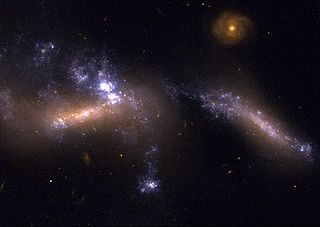
NGC 1741 is a distant pair of interacting galaxies in the Eridanus constellation. It was discovered on 6 January 1878 by French astronomer Édouard Stephan. As a result of the collision, the galaxies are in a rapid starburst phase. The galaxies are classed as Wolf–Rayet galaxies due to their high content of rare Wolf–Rayet stars.

NGC 4647 is an intermediate spiral galaxy estimated to be around 63 million light-years away in the constellation of Virgo. It was discovered by astronomer William Herschel on March 15, 1784. NGC 4647 is listed along with Messier 60 as being part of a pair of galaxies called Arp 116; their designation in Halton Arp's Atlas of Peculiar Galaxies. The galaxy is located on the outskirts of the Virgo Cluster.

NGC 4633 is a spiral galaxy located about 70 million light-years away in the constellation of Coma Berenices. It is interacting with the nearby galaxy NGC 4634. NGC 4633 was discovered by astronomer Edward D. Swift on April 27, 1887. It was rediscovered on November 23, 1900, by astronomer Arnold Schwassmann and was later listed as IC 3688. NGC 4633 is a member of the Virgo Cluster.

PGC 44691 is a spiral galaxy located about 350 million light-years away in the constellation Coma Berenices. It belongs to a galaxy cluster known as the Coma Cluster. In 1994, the Hubble Space Telescope observed PGC 44691 and the nearby elliptical galaxy NGC 4881 to infer the distance to the Coma Cluster.

NGC 806 is a spiral galaxy approximately 166 million light-years away from Earth in the constellation Cetus. It was discovered by American astronomer Lewis A. Swift on November 1, 1886 with the 16" refractor at Warner Observatory.

NGC 6040 is a spiral galaxy located about 550 million light-years away in the constellation Hercules. NGC 6040 was discovered by astronomer Édouard Stephan on June 27, 1870. NGC 6040 is interacting with the lenticular galaxy PGC 56942. As a result of this interaction, NGC 6040's southern spiral arm has been warped in the direction toward PGC 56942. NGC 6040 and PGC 56942 are both members of the Hercules Cluster.

NGC 521, also occasionally referred to as PGC 5190 or UGC 962, is a barred spiral galaxy located approximately 224 million light-years from the Solar System in the constellation Cetus. It was discovered on 8 October 1785 by astronomer William Herschel.

NGC 918 is a barred spiral galaxy in the constellation Aries, about 67 million light years from the Milky Way. It was discovered by John Herschel on Jan 11, 1831.

NGC 997 is an interacting galaxy in the constellation of Cetus. The galaxy was discovered by Albert Marth on 10 November 1863. It has a regularly rotating central molecular gas disk, containing a black hole of between 4 x 107 and 1.8 x 109 solar masses. Its speed relative to the cosmological background is 6,270 ± 45 km/s, corresponding to a Hubble distance of 92.5 ± 6.5 Mpc (~302 million ly).
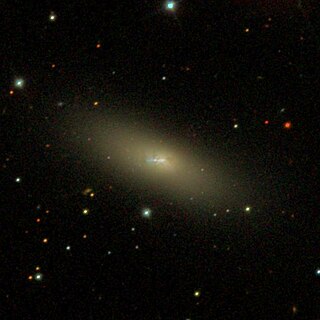
NGC 855 is a star-forming dwarf elliptical galaxy located in the Triangulum constellation. The discovery and a first description was realized by William Herschel on 26th October 1786 and the findings made public through his Catalogue of Nebulae and Clusters of Stars, published the same year.

NGC 7329 is a large barred spiral galaxy located in the constellation Tucana. NGC 7329 was discovered by British astronomer John Herschel in 1835.

NGC 3110, known as NGC 3122 and NGC 3518 is an active spiral galaxy in the Constellation Sextans. It contains extensive Hubble-type Sb star-forming regions, and is located south of the celestial equator. It is estimated to be 218 million light-years from the Milky Way and has a diameter of around 100,000 ly. Together with PGC 29184 it forms a gravitationally bound galaxy pair. Located in the same area of the sky is the galaxy IC 589.
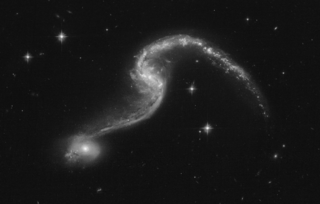
NGC 646 is a large barred spiral galaxy located in the constellation Hydrus. Its speed relative to the cosmic microwave background is 8,145 ± 19 km/s, which corresponds to a Hubble distance of 120.1 ± 8.4 Mpc. NGC 646 was discovered by British astronomer John Herschel in 1834. It forms an interacting galaxy pair.

IC 4271 is a spiral galaxy located some 800 million light-years away in the Canes Venatici constellation. It is 130,000 light-years in diameter. IC 4271 was first located on July 10, 1896, by Stephane Javelle, a French astronomer. It hosts a Seyfert type 2 nucleus, containing an acceleration disc around its supermassive black hole which releases large amounts of radiation, hence its bright appearance. IC 4271 appears to be interacting with its smaller neighboring galaxy, PGC 3096774.
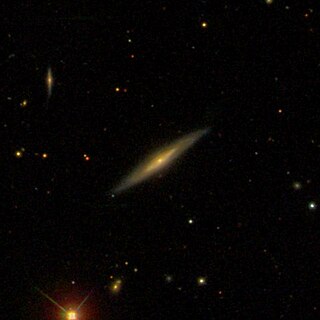
NGC 1009 is a large spiral galaxy in the constellation Cetus. Its speed relative to the cosmic microwave background is 5,594 ± 24 km/s, which corresponds to a Hubble distance of 82.5 ± 5.8 Mpc. NGC 1009 was discovered by American astronomer Edward Swift in 1886. The luminosity class of NGC 1009 is II and it has a broad HI line. To date, five non-redshift measurements yield a distance of 91.940 ± 3.045 Mpc, which is just outside the distance values of Hubble.
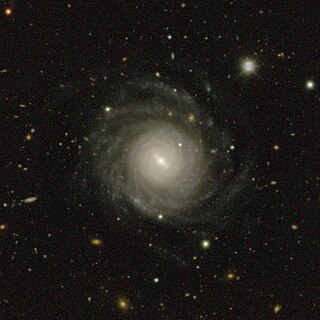
NGC 626 is a very large barred spiral galaxy located in the constellation Sculptor. Its speed relative to the cosmic microwave background is 5,475 ± 16 km/s, which corresponds to a Hubble distance of 80.8 ± 5.7 Mpc. NGC 626 was discovered by British astronomer John Herschel in 1834.
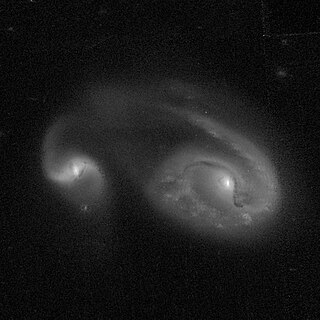
NGC 5279 is a spiral galaxy in the constellation Ursa Major. It was discovered by German-British astronomer William Herschel in 1789. NGC 5279 is in gravitational interaction with the galaxy NGC 5278. This pair of galaxies appears in Halton Arp's Atlas of Peculiar Galaxies under the designation Arp 239. The luminosity class of NGC 5279 is I1. NGC 5279 is a galaxy whose core shines in the ultraviolet region. It is listed in the Markarian catalog under the designation Mrk 271.
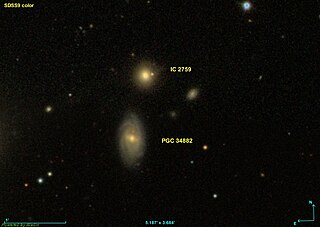
IC 2759 is a small type E elliptical galaxy located in the constellation of Leo. It is located 350 million light-years away from the Solar System and was discovered on April 24, 1897, by Guillaume Bigourdan. Sometimes IC 2759 is confused with the spiral galaxy, PGC 34882 which is located south of the galaxy.
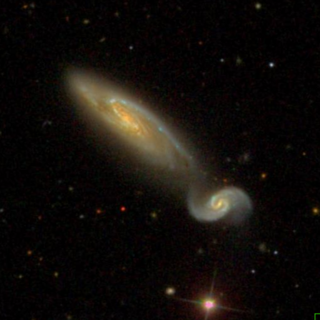
NGC 3800 is an intermediate spiral galaxy located in the constellation Leo. Its speed relative to the cosmic microwave background is 3,653 ± 24 km/s, which corresponds to a Hubble distance of 53.9 ± 3.8 Mpc. NGC 3800 was discovered by German-British astronomer William Herschel in 1784.

NGC 3799 is a barred spiral galaxy located in the constellation Leo. Its speed relative to the cosmic microwave background is 3,659 ± 24 km/s, which corresponds to a Hubble distance of 54.0 ± 3.8 Mpc. NGC 3799 was discovered by British astronomer John Herschel in 1832.




















